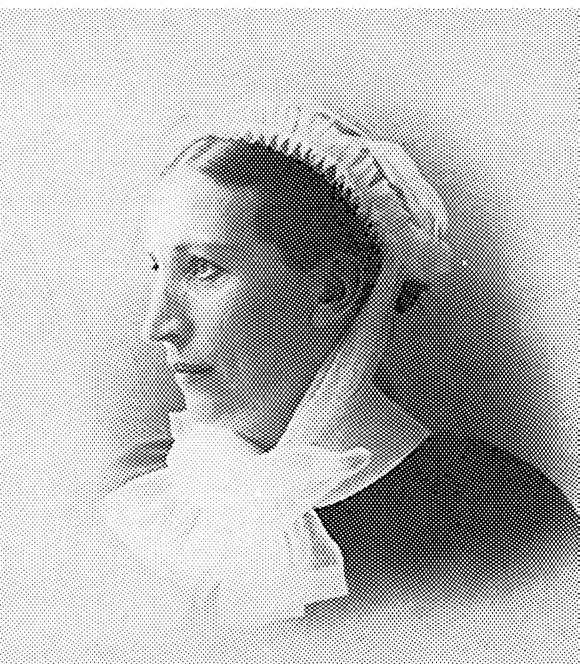by Laura J. Gifford—
The funny thing about angels is that we paint them as lovely and sweet, charming and even cherubic, yet whenever they appear in the Bible, their first words tend to be “Do not be afraid.” Sometimes we see artistic depictions of a fierce Gabriel or an imposing Michael. However, most depictions of angels, particularly female ones, seem created for looks, not for action—hardly the formidable messengers of God we read about in the Gospels!
Real messengers of good news and mercy not only come in all shapes and sizes, but would rarely be described as shrinking violets. Think about the most beloved woman of valor you can recall from your family or congregation, neighborhood or community. Chances are she’s not only a vessel of grace and goodwill, but also someone you wouldn’t want to mess with when she’s on a roll. “Do not be afraid,” indeed. Give these women some room to maneuver!
One such angel of Lutheran heritage is Sister Elisabeth Fedde, a deaconess from Norway who spent much of her working life in the United States. Sister Elisabeth tussled with the men put in charge of her missions and delivered strong words when she needed to (also maybe sometimes when she didn’t). Combining her tireless personal ministry to impoverished Norwegian Brooklynites with her organizational acumen, she founded two major hospitals.
Elisabeth was born on Christmas Day 1850 in the small town of Fedde, Norway. When she was only 13 years old, her mother died. Like many young women of limited means, she prepared to enter domestic service. She took a position in the home of a Stavanger shoemaker and local leader in the mid- 19th-century Lutheran Pietist movement. Deeply impressed by her employers’ heartfelt faith, young Elisabeth prayed for a way she might serve God. One day a visiting seamstress remarked that the conscientious young maid ought to be a deaconess. This was a new idea for Elisabeth, but soon she recognized God’s call. Elisabeth entered the Deaconess Motherhouse in Christiania (modern-day Oslo) in 1874.
The Christiania motherhouse was an outgrowth of the Lutheran deaconess movement established in the 1830s by German pastor Theodore Fliedner. Lutheran deaconesses remained single, lived together in community and trained primarily as nurses. Previously, nurses were typically women with few resources who were regarded as slovenly and untrained. The deaconess movement was one of many 19th-century developments in the nursing
profession, alongside the reforming efforts of England’s Florence Nightingale and the work of Clara Barton during the American Civil War.
Sister Elisabeth had much to learn as a nurse and as a minister— for the duties of a deaconess were spiritual as much as medical. While the women’s male pastoral overseers might not have appreciated deaconesses as ministers, deaconesses experienced a call and provided pastoral care to those they encountered. Deaconesses were a vital component of the “inner mission” movement in Europe and the United States.
Sister Elisabeth would play a pivotal role in the latter. Sister Elisabeth spent her first years in a number of posts at the motherhouse and elsewhere in Norway. In October 1882, however, she received an intriguing letter from her brother-in-law in New York City. The wife of the Norwegian consul in Brooklyn was promising a $150 annual contribution for “a Bible woman who would work here with the poor and lost sheep among the Norwegians,” according to Gracia Grindal, author of Sister Elisabeth Fedde: “To Do the Lord’s Will” (Lutheran University Press,
2014, p. 79). After careful prayer and discernment—and with the approval of her mother superior in Christiania—Sister Elisabeth answered the call. She arrived in Brooklyn on April 10, 1883. Nine days later she met with local
Norwegian pastors to establish the Voluntary Relief Society for the Sick and Poor among the Norwegians in New York and Brooklyn.
Now Sister Elisabeth had an organization with a name. She had the oversight of three Lutheran pastors who served as chairman, secretary and treasurer. What she didn’t have was a place to work. Over the next several weeks she located a small apartment that served as her first headquarters. She began to develop her new charity from scratch.
The conditions Sister Elisabeth faced in the immigrant communities of Brooklyn were nothing short of
shocking. Exhaustion was a common theme in the journals she kept of her early years in Brooklyn. She purchased a basket to carry that would always be full of food and clothing. One scholar noted that if Florence Nightingale was “the Lady with the Lamp,” Sister Elisabeth quickly became known as “the Lady with the Basket” (Grindal, p. 96). Initially Sister Elisabeth traveled miles on foot and by trolley to serve impoverished immigrants. Soon she realized a more established hospital would better meet people’s needs. So in 1885, the Relief Society established a nine-bed hospital that grew into the Deaconess Hospital in Brooklyn.
While Sister Elisabeth enjoyed the support of the Norwegian immigrant community, she sometimes clashed with the pastors who oversaw New York’s inner missions. An eminently practical woman, Sister Elisabeth pushed stridently for any measures that might raise much-needed money for her hospital—including rafflesand games of chance. Such fundraisers gave her frequent nemesis, the pious Pastor Carl Everson, fits. Others were frequently called upon to adjudicate these quarrels. Even so, Fedde’s work continued. On April 19, 1888, Brooklyn’s Norwegian community not only celebrated the fifth anniversary of the Norwegian Relief Society, but also laid the cornerstone for a new Norwegian Hospital and Deaconess Motherhouse.
Sister Elisabeth’s work in Brooklyn brought her increasing renown in other parts of the United States. When she made an 1888 trip to visit family and friends in the Midwest, local Lutheran leaders urged her to visit Minneapolis. In September 1888, Minneapolis was a busy place: One of the largest associations of Lutherans at the time, the General Council of Lutherans in America, was holding its convention in the city. Sister Elisabeth found herself in a room with leading lights of the Norwegian Lutheran community in the Midwest. They urged her to bring her gifts to Minneapolis, which needed a Norwegian hospital. Lutheran leaders wanted a deaconess motherhouse to run it. Would Sister Elisabeth oblige? Reluctantly she agreed to help, and by November 1888, the new Deaconess Institute was up and running in Minneapolis.
This article is excerpted from the April 2021 issue of Gather magazine. To read more like it, subscribe to Gather.




My mother, Ella Gai (Midtbo) graduated from the nursing school of Lutheran Deaconess Hospital in Brooklyn, NY in 1939. I was born at that same hospital in 1942. I was so happy to read this article.